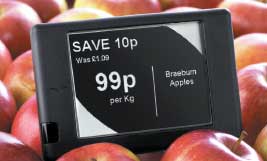Pioneering electronic display technology that could replace paper labels or signs in a host of applications will begin UK trials this summer.
Developed by Malvern-based ZBD Displays, the ‘zero power’ LCD screens will be installed in July at a branch of a leading UK supermarket.
ZBD business development manager Manoj Thanigasalam declined to reveal the identity of the supermarket, but confirmed that, if the trials are successful, the system will be rolled out across a number of branches.
The technology differs considerably from existing LCD screens that require an image to be rewritten at least 30 times every second. Instead, ZBD’s passive matrix LCD display only uses power when the image is changed. When the device is switched off, the information remains visible.
The display relies on liquid crystal molecules that have two stable energy states in which they reflect either black or white. These molecules are sandwiched between two surfaces, which have been stamped to form a series of tiny grooves and ridges. This grating surface aligns the molecules into their stable positions. Each molecule can be switched between the two states using a very low amount of electricity.

Thanigasalam said that the technology is attractive to supermarkets for a number of reasons. As well as reducing the high labour costs associated with constantly replacing food labels, he said that the system will also help prevent mis-pricing between shelves and tills.
More insidiously, it is also expected to provide advertisers with a handy new platform for targeting prospective customers at the point of sale.
A full-colour version of the system, due to be launched in 18 months time, is expected to be particularly appealing for the latter application.
Thanigasalam, who estimates the market for the devices to be worth over $4bn (just over £2bn) said that a typical installation of the technology will pay for itself within a year.
In addition to the trial partner, a number of other leading supermarkets have also expressed interest, and tests begin later this year at an undisclosed electronics retailer. But applications don’t stop at the retail sector. The technology could also be used in mobile phones and PDAs; when typing for instance, the display would allow an image to be partially updated, offering potentially big power savings.
Thanigasalam said that he has even been approached by one car manufacturer interested in using the technology as a silent replacement to a production line tannoy system.




Nanogenerator consumes CO2 to generate electricity
Nice to see my my views being backed up by no less a figure than Sabine Hossenfelder https://youtu.be/QoJzs4fA4fo